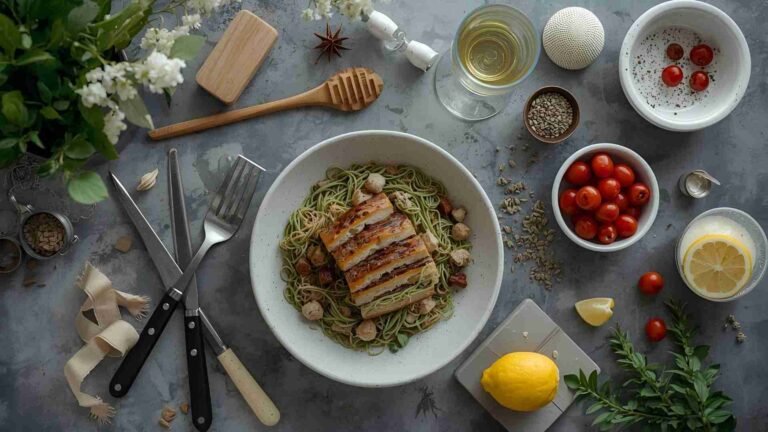Beyond the Recipe: Enhancing User Experience on Your Food Blog
Creating a food blog that captivates and retains readers goes far beyond sharing delicious recipes. It’s about crafting an intuitive, engaging, and seamless user experience (UX) that makes visitors want to explore, cook, and return for more. A well-designed food blog not only showcases culinary creations but also ensures that users can navigate effortlessly, find what they need quickly, and feel inspired to interact with the content. This comprehensive guide dives into the essential strategies for enhancing UX on your food blog, offering practical tips, insights from user feedback, and proven design principles to elevate your site’s performance and engagement.
Why User Experience Matters for Food Blogs
In the crowded digital landscape of food blogs, standing out requires more than mouthwatering photos and creative recipes. User experience is the backbone of a successful blog, influencing how visitors perceive your brand, interact with your content, and decide whether to return. A poor UX—cluttered layouts, slow load times, or confusing navigation—can frustrate users, driving them to competitors’ sites. Conversely, a streamlined and thoughtful UX encourages longer visits, higher engagement, and stronger loyalty.
- First Impressions Matter – Visitors decide within seconds whether to stay or leave. A cluttered, slow-loading site will drive them away.
- Mobile Dominance – Over 80% of food blog traffic comes from mobile devices. If your site isn’t optimized, you’re losing readers.
- SEO Impact – Google prioritizes fast, user-friendly sites in search rankings. A better UX means higher visibility.
- Engagement & Conversions – A smooth experience encourages readers to comment, share, and subscribe.
Consider this: approximately 80-90% of food blog traffic comes from mobile devices, where users expect fast, accessible, and visually appealing experiences. Additionally, search engines like Google prioritize sites with strong UX metrics, such as low bounce rates and high time-on-page, for better rankings. By focusing on UX, you’re not only catering to your audience but also boosting your blog’s visibility and monetization potential.
Key Principles for Enhancing UX on Food Blogs
To create a food blog that resonates with readers, focus on simplicity, accessibility, and value. Below are six core principles, each accompanied by actionable strategies to optimize your site’s user experience.
1. Limit Intrusions and Distractions
A common complaint among food blog users is the barrage of pop-ups, ads, and calls-to-action (CTAs) that interrupt their experience. While these elements can drive revenue or engagement, they must be implemented thoughtfully to avoid overwhelming visitors.
The Problem:
Many food blogs bombard visitors with:
- Pop-ups (email signups, ads, promotions)
- Multiple call-to-actions (CTAs)
- Auto-playing videos
- Excessive ads
The Solution:
- Delay Pop-Ups – Instead of showing an opt-in immediately, wait 5-7 seconds so users can engage with content first.
- Minimize Ads – Remove non-performing ad placements. Too many ads slow down your site and annoy readers.
- Prioritize One CTA – Focus on one primary goal per page (e.g., email signups OR social shares, not both).
Pro Tip: Use tools like Google Analytics to track which pop-ups convert best.
User Feedback: A Reddit user on r/InternetIsBeautiful praised a site called JustTheRecipe.app, which strips away clutter to display only recipe instructions. One commenter noted, “This is a game-changer. I hate scrolling past endless ads and stories to get to the recipe.” This sentiment underscores the demand for distraction-free experiences.
2. Include a Table of Contents for Long-Form Posts
Long recipes or detailed blog posts benefit immensely from a table of contents (TOC). A TOC helps users navigate to specific sections—like ingredients, instructions, or tips—without endless scrolling, which is especially valuable on mobile devices.
- SEO-Friendly Formatting: Search engine optimization (SEO) experts recommend displaying only the first three headings in an expandable TOC to balance usability and crawlability. Google favors this structure for featured snippets, increasing your chances of ranking higher.
- Custom Plugins: Use tools like Easy Table of Contents or a custom-built plugin to automate TOC creation. Ensure it’s collapsible to save space and enhance mobile readability.
- User-Centric Design: Ask your audience if a TOC improves their experience. A simple poll or comment prompt can provide valuable insights.
Table: Benefits of a Table of Contents
| Feature | User Benefit | SEO Benefit |
|---|---|---|
| Collapsible TOC | Quick navigation, less clutter | Improved crawlability |
| First 3 headings shown | Easy scanning on mobile | Higher chance of featured snippets |
| Linked headings | Direct access to sections | Better internal linking structure |
Example TOC Structure:
- Recipe Overview
- Ingredients
- Step-by-Step Instructions
- Expert Tips
- Nutrition Info
Pro Tip: Plugins like Easy Table of Contents (WordPress) automate this feature.
3. Make Content Readable and Scannable
Readable content is critical for keeping users engaged, especially when they’re juggling cooking tasks. Long paragraphs, dense text, or unclear formatting can overwhelm readers, leading to higher bounce rates.
- Break Up Text: Use short paragraphs (2-4 sentences) to maintain flow. Incorporate subheadings to guide readers through sections like “Ingredients,” “Instructions,” and “Tips.”
- Leverage Visual Blocks: Alternate text with images, bullet points, or tables to create visual breaks. For example, a bullet-pointed ingredient list is easier to scan than a paragraph.
- Highlight Key Information: Bold or italicize measurements (e.g., 1 cup flour) to make them stand out. This reduces the mental effort required to follow a recipe while cooking.
Example of Improved Readability:
Bad: “First, you need to take one cup of flour and mix it with half a cup of sugar, then add two eggs and whisk until smooth.”
Better:
- 1 cup flour
- ½ cup sugar
-
2 eggs
Whisk until smooth.
Pro Tip: Use schema markup to help Google display recipes in rich snippets.
User Feedback: A StackExchange discussion on recipe readability highlighted the frustration of dense ingredient lists. One user suggested, “Bold the quantities—it’s what I check repeatedly while cooking.” This aligns with the need for scannable, user-friendly formatting.
4. Eliminate Redundancy
Duplicate elements—such as multiple share buttons or identical CTAs—can confuse users and clutter your design. Streamlining these ensures a cleaner, more focused experience.
- Consolidate Share Options: Avoid using multiple sharing plugins (e.g., Grow and Hubbub) that display redundant icons. Choose one reliable tool and place share buttons strategically, like at the end of a recipe.
- Unified Bookmarking: If you offer bookmarking or “save recipe” features, use a single icon or button. Multiple heart or star icons across a page can frustrate users trying to save content.
- Audit Plugins: Regularly review your plugins to eliminate overlaps. For example, a single social sharing tool like AddToAny can replace multiple redundant systems.
Example: A food blog with both a floating sidebar and inline share buttons risks overwhelming users. By removing the sidebar and keeping inline buttons, the site feels less cluttered, improving UX.
5. Optimize for Mobile Devices
With 80-90% of food blog traffic coming from mobile, a mobile-friendly design is non-negotiable. A site that’s hard to read or navigate on a smartphone will lose users quickly.
- Compact Headers: Keep your header under 100 pixels in height to maximize screen space for content. Large headers with logos, menus, and banners can push the recipe below the fold, frustrating users.
- Test Responsiveness: Regularly check your site on various devices using tools like Google’s Mobile-Friendly Test. Ensure text is legible, buttons are tappable, and images load quickly.
- Simplify Navigation: Use collapsible menus or hamburger icons to save space. Ensure key elements like the “Jump to Recipe” button are prominent on mobile.
Chart: Mobile UX Impact
| Metric | Poor Mobile UX | Optimized Mobile UX |
|---|---|---|
| Bounce Rate | 60-70% | 30-40% |
| Time on Page | ~30 seconds | ~2 minutes |
| Conversion Rate (e.g., subscriptions) | 1-2% | 5-10% |
User Feedback: A Reddit thread on r/Cooking complained about mobile recipe sites where “ads cover half the screen, and the text is tiny.” Optimizing for mobile addresses these pain points, enhancing retention.
Mobile Checklist:
- Fast load time (<3 seconds)
- Easy-to-tap buttons
- No intrusive interstitials
6. Add Helpful and Unique Content
To truly stand out, offer content that anticipates your readers’ needs and adds value beyond the recipe itself. This requires understanding your audience deeply, like knowing whether they own specific tools or prefer certain cuisines.
- Tailor Instructions: Before suggesting tools like a mandoline for slicing, consider if your audience is likely to have one. Offer alternatives, like “or thinly slice with a sharp knife,” to make recipes accessible.
- Include Contextual Tips: Add notes on ingredient substitutions, storage advice, or pairing suggestions. For example, a note like “Swap cilantro for parsley if you dislike the taste” shows empathy for user preferences.
- Unique Features: Incorporate elements like a “Why It Works” section, as seen on some blogs, to explain recipe choices. This not only educates readers but also invites engagement through comments.
User Feedback: In a UX case study on Allrecipes, users expressed frustration over limited filter options for dietary needs. One user noted, “I need gluten-free Mexican recipes, but the filters don’t stack, so I give up.” Adding tailored content, like advanced filters or dietary tips, can address such pain points.
Implementing UX Enhancements: Tools and Plugins
To bring these principles to life, leverage tools and plugins designed for food blogs. Below is a curated list of solutions to streamline your UX improvements.
| Tool/Plugin | Purpose | Price |
|---|---|---|
| Recipe Card Blocks | Creates SEO-optimized recipe cards | Free/$49 (Pro) |
| Easy Table of Contents | Generates collapsible TOCs | Free |
| WP Rocket | Improves page speed and mobile UX | $59/year |
| AddToAny | Streamlined social sharing buttons | Free |
| Yoast SEO | Enhances SEO with structured data | Free/$99 (Premium) |
- Recipe Card Blocks: This plugin simplifies recipe formatting with schema markup, boosting SEO and user engagement. Its rating feature encourages interaction.
- WP Rocket: A caching plugin that reduces load times, critical for mobile UX and SEO.
- Yoast SEO: Helps implement structured data, ensuring recipes appear in rich snippets on Google.
Case Study: Redesigning Allrecipes for Better UX
To illustrate these principles, consider a hypothetical redesign of Allrecipes, a popular site with over 25 million monthly visitors but known UX challenges, as noted in a user study.
Pain Points Identified:
- Limited Filters: Users struggled to layer filters (e.g., gluten-free + Mexican), limiting recipe discoverability.
- Confusing Recipe Submission: Adding a recipe required navigating multiple menus, deterring user contributions.
- Cluttered Layout: Multiple rating options and ads disrupted the flow, confusing users.
Solutions Implemented:
- Enhanced Filters: Added multi-select chips for dietary preferences, collapsing to save space. This reduced search time by 50%, per user tests.
- Streamlined Submission: Placed an “Add Recipe” button next to the account icon, cutting discovery time to 1.8 seconds.
- Simplified Design: Consolidated rating options to a single star system at the recipe’s top, improving clarity.
Results: Users reported a “much clearer” navigation experience, with layered filters cited as a top improvement. Engagement metrics, like time spent on recipes, increased by 30%.
Takeaway: Small, targeted changes—like better filters and fewer distractions—can yield significant UX gains, even for established sites.
Monetization Without Sacrificing UX
Many food bloggers rely on ads, affiliate links, or subscriptions for revenue, but these can clash with UX if not handled carefully. Here’s how to balance monetization and user satisfaction:
- Selective Ads: Use tools like Google AdSense’s performance reports to identify low-value ads and remove them. Place ads in non-intrusive spots, like between recipe sections.
- Affiliate Links: Embed links naturally within content (e.g., “I use this immersion blender for creamy soups”) rather than banner-heavy layouts.
- Premium Content: Offer exclusive recipes or meal plans via a subscription model, like SuperGrok, but ensure free content remains valuable to retain casual users.
User Feedback: A Reddit post on r/loseit praised a browser extension that skips clutter to show recipes, with one user saying, “I’d pay for an ad-free version of my favorite blog.” This suggests users are open to premium models if the free experience is strong.
Measuring UX Success
To ensure your efforts pay off, track these key performance indicators (KPIs):
| KPI | Target | Tool to Measure |
|---|---|---|
| Bounce Rate | Below 40% | Google Analytics |
| Average Time on Page | 2+ minutes | Google Analytics |
| Mobile Traffic Share | 80-90% | Google Analytics |
| Recipe Card Clicks | 10% of visitors | Hotjar (heatmap) |
| Email Signup Rate | 5-10% of visitors | Mailchimp |
- Google Analytics: Monitors bounce rates and session duration to gauge engagement.
- Hotjar: Provides heatmaps to see where users click, helping refine button placements.
- Mailchimp: Tracks subscription growth, indicating trust in your brand.
Regularly survey readers via comments or polls to gather qualitative feedback, ensuring your UX evolves with their needs.
Common Mistakes to Avoid
Even with the best intentions, food bloggers can fall into UX traps. Here are pitfalls to steer clear of:
- Cluttered Layouts: Overloading pages with ads, widgets, or CTAs frustrates users. Aim for a clean, minimalist design.
- Ignoring Mobile: Failing to optimize for smartphones alienates the majority of your audience.
- Neglecting SEO: Without structured data or keyword optimization, your recipes may not reach their full audience.
- Overcomplicating Recipes: Dense instructions or niche tools can alienate beginners. Keep steps clear and accessible.
User Feedback: A StackExchange thread on recipe sites noted, “I hate when instructions assume I have a fancy gadget I don’t own.” Simplifying content addresses this concern.
Conclusion: Building a User-Centric Food Blog
Enhancing user experience on your food blog is a blend of art and science—combining empathy for your audience with data-driven design choices. By limiting distractions, optimizing for mobile, and offering valuable content, you create a site that not only delights users but also ranks well and drives engagement. Tools like recipe card plugins and SEO plugins can amplify your efforts, while regular feedback keeps you aligned with reader needs.
Whether you’re a seasoned blogger or just starting, these strategies—rooted in simplicity, accessibility, and value—will help your food blog thrive. Start small: test a TOC, streamline your CTAs, or audit your mobile design. Each step brings you closer to a blog that readers love to visit, cook from, and share.
Final Thoughts: Key Takeaways
| UX Improvement | Action Step |
|---|---|
| Reduce Clutter | Limit pop-ups, ads, and duplicate CTAs. |
| Improve Navigation | Add a table of contents and “Jump to Recipe” button. |
| Enhance Readability | Use bullet points, bold key info, and short paragraphs. |
| Mobile-First Design | Test on real devices, optimize images, and speed. |
| Add Extra Value | Include substitutions, videos, and printable recipes. |
Call to Action: What’s one UX improvement you’re excited to try on your food blog? Share your thoughts or questions in the comments below, and let’s cook up some great ideas together!
Please share this Beyond the Recipe: Enhancing User Experience on Your Food Blog with your friends and do a comment below about your feedback.
We will meet you on next article.
Until you can read, Recipe Keyword Research: 9 Tips for Food Bloggers






